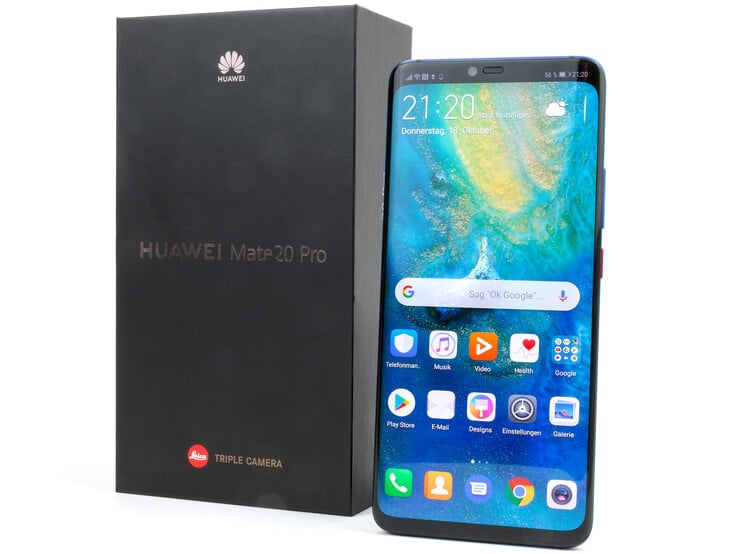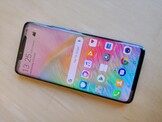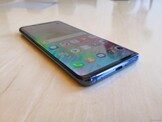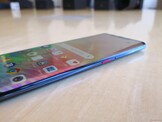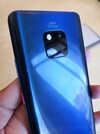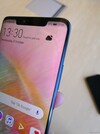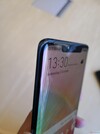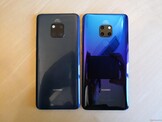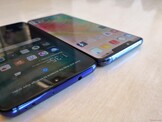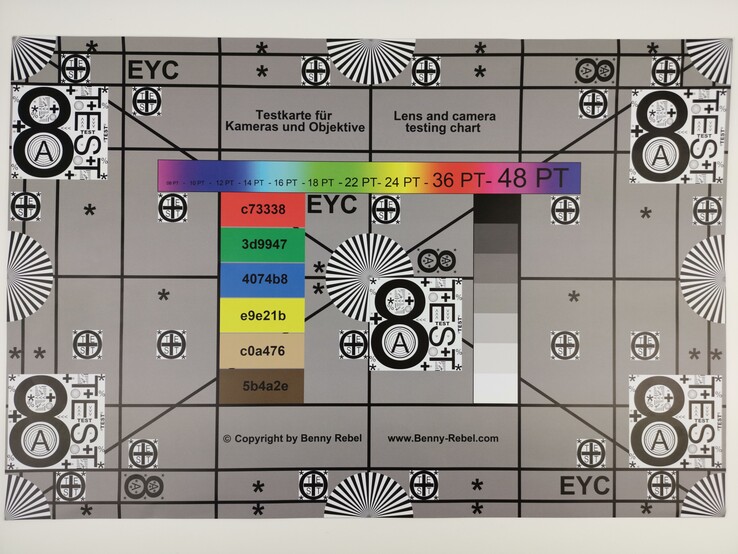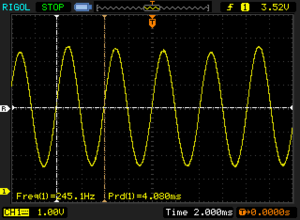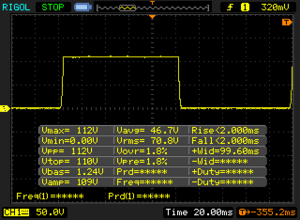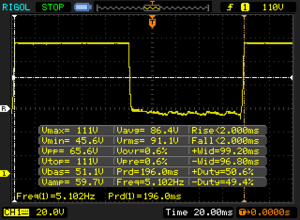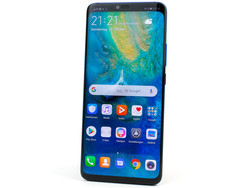华为Mate 20 Pro智能手机评测
» Notebookcheck多媒体笔记本电脑Top 10排名
» Notebookcheck游戏笔记本电脑Top 10排名
» Notebookcheck低价办公/商务笔记本电脑Top 10排名
» Notebookcheck高端办公/商务笔记本电脑Top 10排名
» Notebookcheck工作站笔记本电脑Top 10排名
» Notebookcheck亚笔记本电脑Top 10排名
» Notebookcheck超级本产品Top 10排名
» Notebookcheck变形本产品Top 10排名
» Notebookcheck平板电脑Top 10排名
» Notebookcheck智能手机Top 10排名
» Notebookcheck评测过最出色的笔记本电脑屏幕
» Notebookcheck售价500欧元以下笔记本电脑Top 10排名
» Notebookcheck售价300欧元以下笔记本电脑Top 10排名
Image comparison
Choose a scene and navigate within the first image. One click changes the position on touchscreens. One click on the zoomed-in image opens the original in a new window. The first image shows the scaled photograph of the test device.
| |||||||||||||||||||||||||
Brightness Distribution: 90 %
Center on Battery: 576 cd/m²
Contrast: ∞:1 (Black: 0 cd/m²)
ΔE ColorChecker Calman: 1.3 | ∀{0.5-29.43 Ø4.78}
ΔE Greyscale Calman: 1.6 | ∀{0.09-98 Ø5}
99.1% sRGB (Calman 2D)
Gamma: 2.18
CCT: 6561 K
| Huawei Mate 20 Pro OLED, 3120x1440, 6.3" | Huawei Mate 10 Pro OLED, 2160x1080, 6" | Samsung Galaxy S9 Plus Super AMOLED, 2960x1440, 6.2" | Sony Xperia XZ2 Premium LCD-IPS, 3840x2160, 5.8" | Apple iPhone Xs Max OLED, 2688x1242, 6.5" | LG G7 ThinQ IPS, 3120x1440, 6.1" | OnePlus 6 Optic AMOLED, 2280x1080, 6.3" | Xiaomi Mi 8 Explorer Edition Super AMOLED, 2248x1080, 6.2" | |
|---|---|---|---|---|---|---|---|---|
| Screen | -10% | -22% | -40% | 1% | -110% | -35% | -62% | |
| Brightness middle (cd/m²) | 576 | 629 9% | 565 -2% | 477 -17% | 656 14% | 974 69% | 430 -25% | 429 -26% |
| Brightness (cd/m²) | 582 | 636 9% | 571 -2% | 453 -22% | 659 13% | 975 68% | 437 -25% | 432 -26% |
| Brightness Distribution (%) | 90 | 94 4% | 96 7% | 86 -4% | 88 -2% | 96 7% | 87 -3% | 88 -2% |
| Black Level * (cd/m²) | 0.33 | 0.49 | ||||||
| Colorchecker dE 2000 * | 1.3 | 1.7 -31% | 2.3 -77% | 2.1 -62% | 1.7 -31% | 5.4 -315% | 2.3 -77% | 3.39 -161% |
| Colorchecker dE 2000 max. * | 3.5 | 3.6 -3% | 4.8 -37% | 8.2 -134% | 2.8 20% | 13.1 -274% | 4.6 -31% | 5.25 -50% |
| Greyscale dE 2000 * | 1.6 | 2.4 -50% | 1.9 -19% | 1.6 -0% | 1.7 -6% | 5 -213% | 2.4 -50% | 3.3 -106% |
| Gamma | 2.18 101% | 2.15 102% | 2.16 102% | 2.28 96% | 1.998 110% | 2.31 95% | 2.28 96% | 2.238 98% |
| CCT | 6561 99% | 6337 103% | 6332 103% | 6425 101% | 6487 100% | 7480 87% | 6160 106% | 7135 91% |
| Contrast (:1) | 1445 | 1988 |
* ... smaller is better
Screen Flickering / PWM (Pulse-Width Modulation)
| Screen flickering / PWM detected | 245.1 Hz | ≤ 99 % brightness setting | |
The display backlight flickers at 245.1 Hz (worst case, e.g., utilizing PWM) Flickering detected at a brightness setting of 99 % and below. There should be no flickering or PWM above this brightness setting. The frequency of 245.1 Hz is relatively low, so sensitive users will likely notice flickering and experience eyestrain at the stated brightness setting and below. In comparison: 53 % of all tested devices do not use PWM to dim the display. If PWM was detected, an average of 8118 (minimum: 5 - maximum: 343500) Hz was measured. | |||
Display Response Times
| ↔ Response Time Black to White | ||
|---|---|---|
| 4 ms ... rise ↗ and fall ↘ combined | ↗ 2 ms rise | |
| ↘ 2 ms fall | ||
| The screen shows very fast response rates in our tests and should be very well suited for fast-paced gaming. In comparison, all tested devices range from 0.1 (minimum) to 240 (maximum) ms. » 15 % of all devices are better. This means that the measured response time is better than the average of all tested devices (20.2 ms). | ||
| ↔ Response Time 50% Grey to 80% Grey | ||
| 4 ms ... rise ↗ and fall ↘ combined | ↗ 2 ms rise | |
| ↘ 2 ms fall | ||
| The screen shows very fast response rates in our tests and should be very well suited for fast-paced gaming. In comparison, all tested devices range from 0.165 (minimum) to 636 (maximum) ms. » 14 % of all devices are better. This means that the measured response time is better than the average of all tested devices (31.6 ms). | ||
| Basemark GPU 1.1 | |
| 1920x1080 Vulkan Medium Offscreen (sort by value) | |
| Huawei Mate 20 Pro | |
| Huawei Mate 10 Pro | |
| OnePlus 6 | |
| LG G7 ThinQ | |
| Average HiSilicon Kirin 980 (25.6 - 30.7, n=2) | |
| Vulkan Medium Native (sort by value) | |
| Huawei Mate 20 Pro | |
| Huawei Mate 10 Pro | |
| OnePlus 6 | |
| LG G7 ThinQ | |
| Average HiSilicon Kirin 980 (16.9 - 28.5, n=2) | |
| 1920x1080 OpenGL Medium Offscreen (sort by value) | |
| Huawei Mate 20 Pro | |
| Huawei Mate 10 Pro | |
| OnePlus 6 | |
| LG G7 ThinQ | |
| Average HiSilicon Kirin 980 (27 - 29.1, n=2) | |
| VRMark - Amber Room (sort by value) | |
| Huawei Mate 20 Pro | |
| Huawei Mate 10 Pro | |
| OnePlus 6 | |
| LG G7 ThinQ | |
| Average HiSilicon Kirin 980 (5020 - 5025, n=2) | |
| Basemark ES 3.1 / Metal - offscreen Overall Score (sort by value) | |
| Huawei Mate 20 Pro | |
| Huawei Mate 10 Pro | |
| Samsung Galaxy S9 Plus | |
| Apple iPhone Xs Max | |
| OnePlus 6 | |
| LG G7 ThinQ | |
| Average HiSilicon Kirin 980 (1571 - 1627, n=2) | |
| Average of class Smartphone (205 - 7731, n=36, last 2 years) | |
| JetStream 1.1 - Total Score | |
| Apple iPhone Xs Max (Safari 12) | |
| Huawei Mate 20 Pro (Chrome 69) | |
| Average HiSilicon Kirin 980 (93.2 - 109.9, n=9) | |
| LG G7 ThinQ (Chrome 66) | |
| OnePlus 6 (Chrome 66) | |
| Xiaomi Mi 8 Explorer Edition (Chrome 69) | |
| Sony Xperia XZ2 Premium (Chrome 68) | |
| Samsung Galaxy S9 Plus (Samsung Browser 7.0) | |
| Huawei Mate 10 Pro (Chrome 61) | |
| Octane V2 - Total Score | |
| Average of class Smartphone (2228 - 121337, n=200, last 2 years) | |
| Apple iPhone Xs Max (Safari 12) | |
| Huawei Mate 20 Pro (Chrome 69) | |
| Average HiSilicon Kirin 980 (20618 - 23285, n=10) | |
| OnePlus 6 (Chrome 66) | |
| LG G7 ThinQ (Chrome 66) | |
| Samsung Galaxy S9 Plus (Samsung Browser 7.0) | |
| Xiaomi Mi 8 Explorer Edition (Chrome 69) | |
| Sony Xperia XZ2 Premium (Chrome 68) | |
| Huawei Mate 10 Pro (Chrome 61) | |
| Mozilla Kraken 1.1 - Total | |
| Huawei Mate 10 Pro (Chrome 61) | |
| Sony Xperia XZ2 Premium (Chrome 68) | |
| LG G7 ThinQ (Chrome 66) | |
| OnePlus 6 (Chrome 66) | |
| Xiaomi Mi 8 Explorer Edition (Chrome 69) | |
| Average HiSilicon Kirin 980 (1948 - 3098, n=10) | |
| Samsung Galaxy S9 Plus (Samsung Browser 7.0) | |
| Huawei Mate 20 Pro (Chrome 69) | |
| Average of class Smartphone (257 - 28190, n=155, last 2 years) | |
| Apple iPhone Xs Max (Safari 12) | |
| WebXPRT 3 - Overall | |
| Average of class Smartphone (38 - 380, n=35, last 2 years) | |
| Apple iPhone Xs Max (Safari 12) | |
| Huawei Mate 20 Pro (Chrome 69) | |
| Average HiSilicon Kirin 980 (86 - 124, n=10) | |
| OnePlus 6 (Chrome 66) | |
| LG G7 ThinQ (Chrome 66) | |
| Sony Xperia XZ2 Premium (Chrome 68) | |
| Samsung Galaxy S9 Plus | |
| WebXPRT 2015 - Overall | |
| Apple iPhone Xs Max (Safari 12) | |
| Huawei Mate 20 Pro (Chrome 69) | |
| Average HiSilicon Kirin 980 (228 - 334, n=5) | |
| OnePlus 6 (Chrome 66) | |
| LG G7 ThinQ (Chrome 66) | |
| Xiaomi Mi 8 Explorer Edition (Chrome 69) | |
| Sony Xperia XZ2 Premium (Chrome 68) | |
| Samsung Galaxy S9 Plus (Samsung Browser 7.0) | |
| Huawei Mate 10 Pro (Chrome 61) | |
* ... smaller is better
| Huawei Mate 20 Pro | Huawei Mate 10 Pro | Samsung Galaxy S9 Plus | Sony Xperia XZ2 Premium | OnePlus 6 | Average 128 GB UFS 2.1 Flash | Average of class Smartphone | |
|---|---|---|---|---|---|---|---|
| AndroBench 3-5 | -5% | -19% | -40% | -28% | -1% | 299% | |
| Sequential Read 256KB (MB/s) | 853 | 732 -14% | 819 -4% | 749 -12% | 726 -15% | 761 ? -11% | 2223 ? 161% |
| Sequential Write 256KB (MB/s) | 196.4 | 208.7 6% | 204.9 4% | 171 -13% | 201.4 3% | 296 ? 51% | 1838 ? 836% |
| Random Read 4KB (MB/s) | 157.4 | 132.3 -16% | 129.7 -18% | 136 -14% | 137 -13% | 154 ? -2% | 295 ? 87% |
| Random Write 4KB (MB/s) | 157.8 | 164.4 4% | 22.74 -86% | 21.75 -86% | 21.8 -86% | 130.4 ? -17% | 335 ? 112% |
| Sequential Read 256KB SDCard (MB/s) | 83.2 ? | 79.2 ? -5% | 34.18 ? -59% | 76 ? -9% | |||
| Sequential Write 256KB SDCard (MB/s) | 72.4 ? | 67.2 ? -7% | 30.23 ? -58% | 59.6 ? -18% |
PUBG Mobile
Arena of Valor (Ultra High)
Asphalt 9: Legends (High)
(±) The maximum temperature on the upper side is 43.3 °C / 110 F, compared to the average of 35.2 °C / 95 F, ranging from 21.9 to 247 °C for the class Smartphone.
(±) The bottom heats up to a maximum of 44.5 °C / 112 F, compared to the average of 34 °C / 93 F
(±) In idle usage, the average temperature for the upper side is 32.8 °C / 91 F, compared to the device average of 32.9 °C / 91 F.
Huawei Mate 20 Pro audio analysis
(±) | speaker loudness is average but good (77.7 dB)
Bass 100 - 315 Hz
(±) | reduced bass - on average 14.2% lower than median
(±) | linearity of bass is average (12.4% delta to prev. frequency)
Mids 400 - 2000 Hz
(±) | higher mids - on average 6.7% higher than median
(+) | mids are linear (5.5% delta to prev. frequency)
Highs 2 - 16 kHz
(±) | higher highs - on average 7.3% higher than median
(+) | highs are linear (6.7% delta to prev. frequency)
Overall 100 - 16.000 Hz
(±) | linearity of overall sound is average (22.9% difference to median)
Compared to same class
» 50% of all tested devices in this class were better, 7% similar, 43% worse
» The best had a delta of 11%, average was 35%, worst was 134%
Compared to all devices tested
» 67% of all tested devices were better, 6% similar, 27% worse
» The best had a delta of 4%, average was 24%, worst was 134%
Sony Xperia XZ2 Premium audio analysis
(+) | speakers can play relatively loud (83.6 dB)
Bass 100 - 315 Hz
(-) | nearly no bass - on average 34.5% lower than median
(±) | linearity of bass is average (9.2% delta to prev. frequency)
Mids 400 - 2000 Hz
(+) | balanced mids - only 4% away from median
(+) | mids are linear (6.3% delta to prev. frequency)
Highs 2 - 16 kHz
(+) | balanced highs - only 3.5% away from median
(+) | highs are linear (3.5% delta to prev. frequency)
Overall 100 - 16.000 Hz
(±) | linearity of overall sound is average (23.9% difference to median)
Compared to same class
» 54% of all tested devices in this class were better, 9% similar, 37% worse
» The best had a delta of 11%, average was 35%, worst was 134%
Compared to all devices tested
» 71% of all tested devices were better, 7% similar, 23% worse
» The best had a delta of 4%, average was 24%, worst was 134%
| Off / Standby | |
| Idle | |
| Load |
|
Key:
min: | |
| Huawei Mate 20 Pro 4200 mAh | Huawei Mate 10 Pro 4000 mAh | Samsung Galaxy S9 Plus 3500 mAh | Sony Xperia XZ2 Premium 3540 mAh | Apple iPhone Xs Max 3174 mAh | Xiaomi Mi 8 Explorer Edition 3000 mAh | OnePlus 6 3300 mAh | LG G7 ThinQ 3000 mAh | Average HiSilicon Kirin 980 | Average of class Smartphone | |
|---|---|---|---|---|---|---|---|---|---|---|
| Power Consumption | 15% | 30% | -1% | 8% | -54% | 17% | -8% | -3% | -13% | |
| Idle Minimum * (Watt) | 0.95 | 0.85 11% | 0.68 28% | 0.67 29% | 1 -5% | 1.8 -89% | 0.6 37% | 1.16 -22% | 0.802 ? 16% | 0.848 ? 11% |
| Idle Average * (Watt) | 2.17 | 1.15 47% | 0.95 56% | 2.5 -15% | 1.4 35% | 2.9 -34% | 1 54% | 1.98 9% | 2.07 ? 5% | 1.435 ? 34% |
| Idle Maximum * (Watt) | 2.25 | 1.23 45% | 1.09 52% | 2.51 -12% | 1.7 24% | 3.5 -56% | 1.6 29% | 2.07 8% | 2.38 ? -6% | 1.621 ? 28% |
| Load Average * (Watt) | 4.47 | 4.12 8% | 4.58 -2% | 4.3 4% | 4.6 -3% | 4.8 -7% | 4.3 4% | 4.51 -1% | 4.87 ? -9% | 6.99 ? -56% |
| Load Maximum * (Watt) | 6.15 | 8.42 -37% | 5.16 16% | 6.87 -12% | 6.7 -9% | 11.2 -82% | 8.6 -40% | 8.3 -35% | 7.46 ? -21% | 11.3 ? -84% |
* ... smaller is better
| Huawei Mate 20 Pro 4200 mAh | Huawei Mate 10 Pro 4000 mAh | Samsung Galaxy S9 Plus 3500 mAh | Sony Xperia XZ2 Premium 3540 mAh | Apple iPhone Xs Max 3174 mAh | Xiaomi Mi 8 Explorer Edition 3000 mAh | OnePlus 6 3300 mAh | LG G7 ThinQ 3000 mAh | |
|---|---|---|---|---|---|---|---|---|
| Battery runtime | 14% | -23% | -27% | -14% | -13% | -5% | -8% | |
| Reader / Idle (h) | 29.1 | 29.1 0% | 22.4 -23% | 22.5 -23% | 21.8 -25% | 23.4 -20% | 30.1 3% | 27.7 -5% |
| H.264 (h) | 14.2 | 15.5 9% | 11.2 -21% | 8.7 -39% | 13.4 -6% | 15.4 8% | 13.2 -7% | 15.1 6% |
| WiFi v1.3 (h) | 12.8 | 13.6 6% | 8.7 -32% | 9.1 -29% | 12.4 -3% | 11.6 -9% | 12.7 -1% | 9.9 -23% |
| Load (h) | 4.7 | 6.6 40% | 4 -15% | 3.9 -17% | 3.7 -21% | 3.2 -32% | 4.1 -13% | 4.3 -9% |
Pros
Cons
华为Mate 20 Pro是一款出色的智能手机,拥有各种旗舰级硬件。该设备是我们第一次接触新款麒麟980 SoC并进行测试。它还有着比P20 Pro更加出色的后置三摄像头。此外,尽管我们的测试设备在刚开始测试时具有相对较高的功耗,但Mate 20 Pro拥有巨大的电池,仍然提供了一流的续航时间。该设备还配备有快速通信模块,快速有线和无线充电,并通过了IP68认证。
华为克服了开发Mate 20 Pro中的重重困难,这不仅仅是一款高端旗舰智能手机。
尽管如此,该设备并非没有缺点。扬声器素质仅略高于平均水平,而有些人可能会认为华为决定将Mate 20 Pro的主扬声器置于其USB Type-C端口内是一个设计缺陷。我们同样不相信华为的新型Nano存储卡,与microSD卡相比,它几乎没有什么实际优势。我们的测试设备也具有相对较高的功耗,不过我们认为这是因为它比零售版附带的软件具有更少的电池优化,但这并不能阻止Mate 20 Pro成为2018年最好的旗舰智能手机之一。
Huawei Mate 20 Pro
- 08/31/2022 v7 (old)
Allen Ngo, Daniel Schmidt




